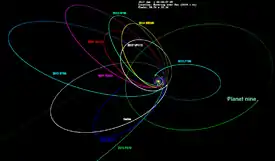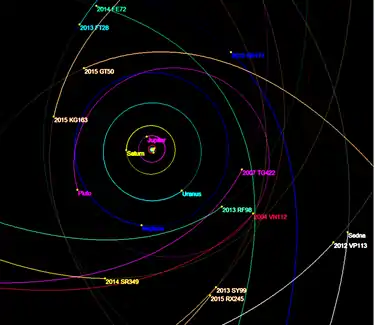2014 FE72
2014 FE72 is a trans-Neptunian object first observed on 26 March 2014, at Cerro Tololo Observatory, La Serena. It is a possible dwarf planet,[5] a member of the scattered disc, whose orbit extends into the inner Oort cloud.[1] Discovered by Scott Sheppard and Chad Trujillo, the object's existence was revealed on 29 August 2016.[1][8] Both the orbital period and aphelion distance of this object are poorly constrained.[2] 2014 FE72 had the largest barycentric aphelion until 2018. However, the heliocentric aphelion of 2014 FE72 is second among trans-Neptunian objects (after the damocloid 2017 MB7).
 Orbits of 2014 FE72 (green, at lower left) and other scattered/detached objects, along with hypothetical Planet Nine on the right | |
| Discovery [1] | |
|---|---|
| Discovered by | |
| Discovery date | 26 March 2014 |
| Designations | |
| 2014 FE72 | |
| Orbital characteristics [2] | |
| Epoch 27 April 2019 (JD 2458600.5) | |
| Uncertainty parameter 4 | |
| Observation arc | 4.14 years (1511 days) |
| Aphelion |
|
| Perihelion | 36.33±0.14 AU |
| |
| Eccentricity | 0.9759±0.0087 |
| 0.33±0.18° | |
| 0° 0m 0.061s ± 0° 0m 0.033s / day | |
| Inclination | 20.655±0.003° |
| 336.883±0.005° | |
| ≈ 17 August 1965[4] ±7 months | |
| 134.162±0.066° | |
| Physical characteristics | |
| Dimensions | 270 km (est. at 0.08)[5][6] |
| 0.08 (assumed)[5] | |
| 24.3[7] | |
| 6.1 | |
Orbit

Its elongated orbit (eccentricity = 0.977) has a perihelion of 36.19 AU, an aphelion of ~3,060 AU and a barycentric orbital period of ~60,900 years.[3] The latter values are the largest known for any Solar System body that is not a long-period comet.[n 1] Based on the barycentric orbital period, 2014 FE72 takes roughly 5 times longer than Sedna to orbit the Sun.[10]
2014 FE72 last passed through perihelion around late 1965.[2]
See also
- List of Solar System objects by greatest aphelion
- List of Solar System objects most distant from the Sun in 2015
Notes
- 2017 MB7, an apparently much smaller object (absolute magnitude ~14) which might be an extinct comet, has a similar barycentric aphelion of ~2,800 AU and an orbital period of ~54,000 years.[9]
References
- Williams, G. V. (29 August 2016). "MPEC 2016-Q43 : 2014 FE72". Minor Planet Center. Retrieved 31 August 2016.
- "JPL Small-Body Database Browser: (2014 FE72)" (2018-05-15 last obs). Jet Propulsion Lab. Archived from the original on 26 August 2018. Retrieved 26 August 2018.
- Horizons. "JPL Horizons: Barycentric Osculating Orbital Elements for 2014 FE72". Retrieved 12 November 2018.
- JPL Horizons Observer Location: @sun (Perihelion occurs when deldot changes from negative to positive. Uncertainty in time of perihelion is 3-sigma.)
- Michael E. Brown. "How many dwarf planets are there in the outer solar system? (updates daily)". California Institute of Technology. Retrieved 15 September 2016.
- "Absolute magnitude (H)". Near Earth Object Program. NASA/Jet Propulsion Lab. Retrieved 15 September 2016.
- "AstDyS 2014FE72 Ephemerides". Department of Mathematics, University of Pisa, Italy. Retrieved 12 November 2018. (Distance to Sun [R] from 2016 to 2020.)
- "Hunt for ninth planet reveals new extremely distant Solar System objects". CarnegieScience.edu. Carnegie Institution. 29 August 2016. Retrieved 31 August 2016.
- JPL Small-Body Database Browser: (2017 MB7)
- Horizons. "JPL Horizons: Barycentric Osculating Orbital Elements for (90377) Sedna". Retrieved 12 November 2018.
External links
- 2014 FE72 at AstDyS-2, Asteroids—Dynamic Site
- 2014 FE72 at the JPL Small-Body Database